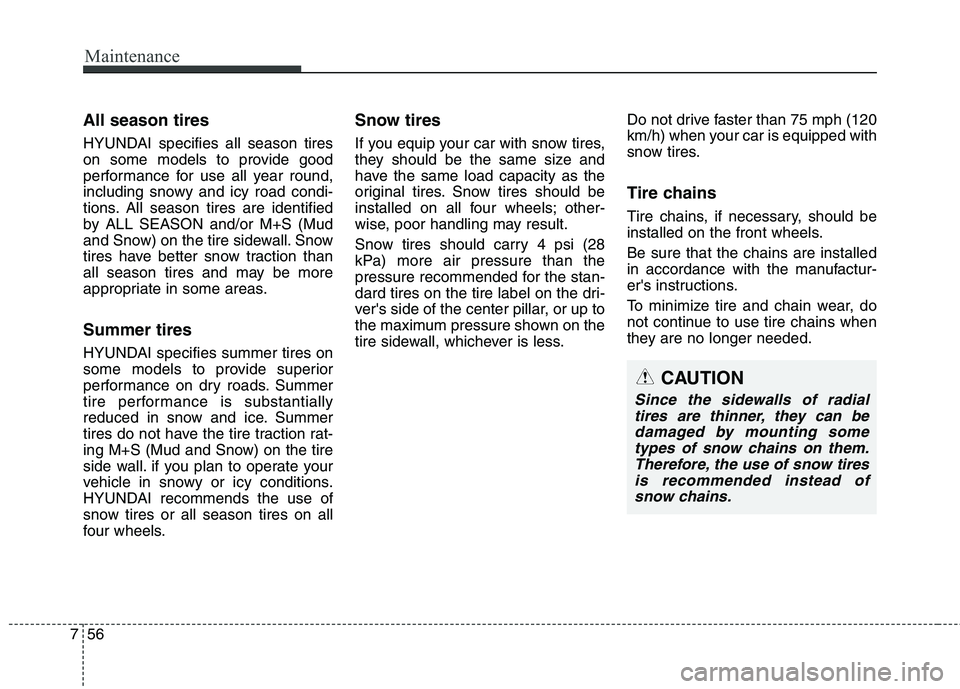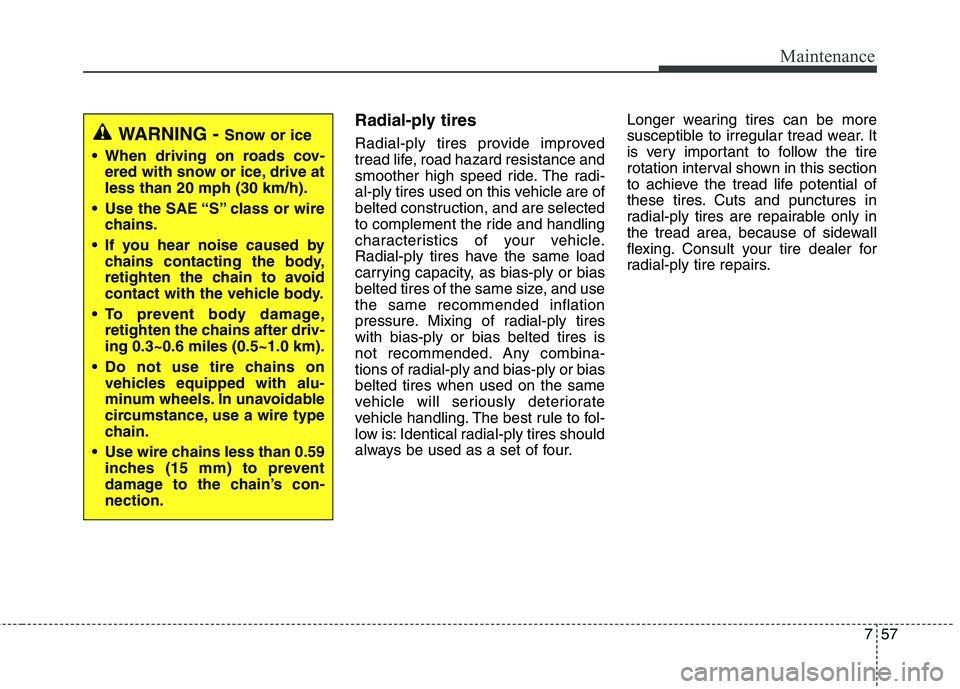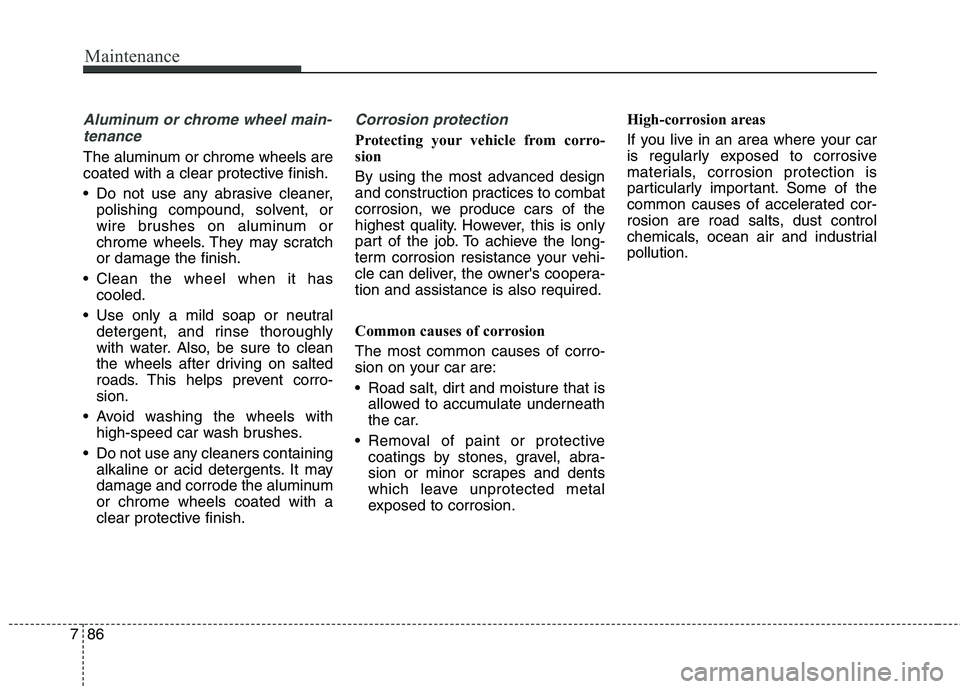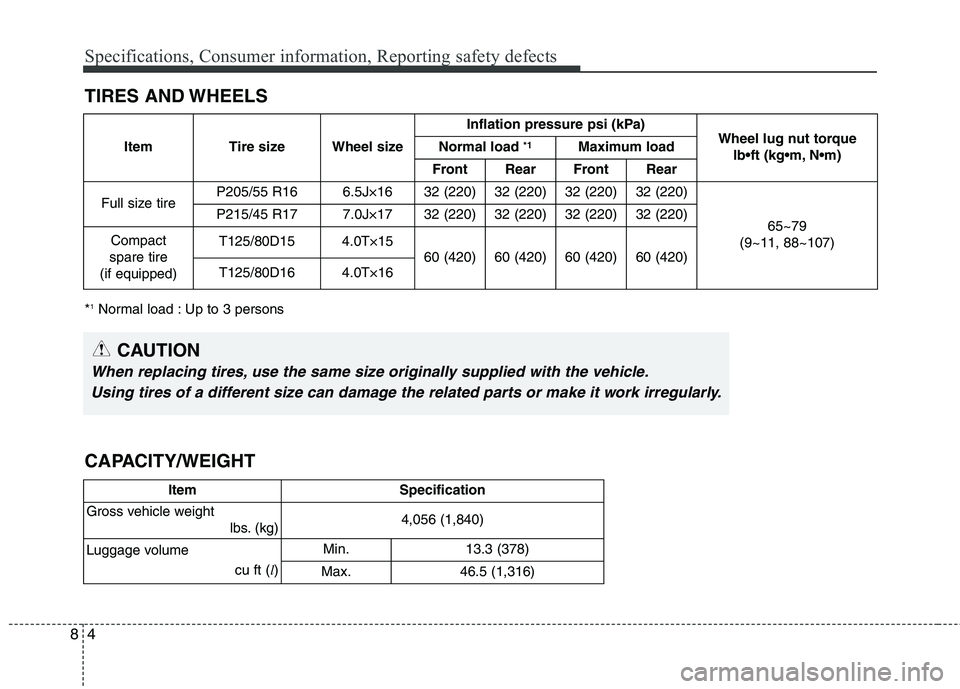2014 HYUNDAI ELANTRA GT Wheels
[x] Cancel search: WheelsPage 410 of 476

749
Maintenance
Compact spare tire replacement
A compact spare tire has a shorter
tread life than a regular size tire.
Replace it when you can see the
tread wear indicator bars on the tire.
The replacement compact spare tire
should be the same size and design
as the one provided with your new
vehicle and should be mounted on
the same compact spare tire wheel.
The compact spare tire is not
designed to be mounted on a regular
size wheel, and the compact spare
tire wheel is not designed for mount-
ing a regular size tire.
Wheel replacement
When replacing the metal wheels for
any reason, make sure the new
wheels are equivalent to the original
factory units in diameter, rim width
and offset.
Tire traction
Tire traction can be reduced if you
drive on worn tires, tires that are
improperly inflated or on slippery
road surfaces. Tires should be
replaced when tread wear indicators
appear. To reduce the possibility of
losing control, slow down whenever
there is rain, snow or ice on the road.
Tire maintenance
In addition to proper inflation, correct
wheel alignment helps to decrease
tire wear. If you find a tire is worn
unevenly, have your dealer check the
wheel alignment.
When you have new tires installed,
make sure they are balanced. This
will increase vehicle ride comfort and
tire life. Additionally, a tire should
always be rebalanced if it is removed
from the wheel.
WARNING
A wheel that is not the correct
size may adversely affect wheel
and bearing life, braking and
stopping abilities, handling
characteristics, ground clear-
ance, body-to-tire clearance,
snow chain clearance,
speedometer and odometer cal-
ibration, headlight aim and
bumper height.
Page 411 of 476

Maintenance
50 7
Tire sidewall labeling
This information identifies and
describes the fundamental charac-
teristics of the tire and also provides
the tire identification number (TIN)
for safety standard certification. The
TIN can be used to identify the tire in
case of a recall.
1. Manufacturer or brand name
Manufacturer or Brand name is
shown.
2. Tire size designation
A tire’s sidewall is marked with a tire
size designation. The following
explains what the letters and numbers
in the tire size designation mean.
Example tire size designation:
(These numbers are provided as an
example only; your tire size designa-
tor could vary depending on your
vehicle.)
P195/65R15 94H
P - Applicable vehicle type (tires
marked with the prefix “P’’ are
intended for use on passenger
cars or light trucks; however, not
all tires have this marking).
195 - Tire width in millimeters.
65 - Aspect ratio. The tire’s section
height as a percentage of its
width.
R - Tire construction code (Radial).
15 - Rim diameter in inches.94 - Load Index, a numerical code
associated with the maximum
load the tire can carry.
H - Speed Rating Symbol. See the
speed rating chart in this section
for additional information.
Wheel size designation
Wheels are also marked with impor-
tant information that you need if you
ever have to replace one. The follow-
ing explains what the letters and
numbers in the wheel size designa-
tion mean.
Example wheel size designation:
6.0JX15
6.0 - Rim width in inches.
J - Rim contour designation.
15 - Rim diameter in inches.
I030B04JM 1
1 2
34 5,6
7
Page 417 of 476

Maintenance
56 7
All season tires
HYUNDAI specifies all season tires
on some models to provide good
performance for use all year round,
including snowy and icy road condi-
tions. All season tires are identified
by ALL SEASON and/or M+S (Mud
and Snow) on the tire sidewall. Snow
tires have better snow traction than
all season tires and may be more
appropriate in some areas.
Summer tires
HYUNDAI specifies summer tires on
some models to provide superior
performance on dry roads. Summer
tire performance is substantially
reduced in snow and ice. Summer
tires do not have the tire traction rat-
ing M+S (Mud and Snow) on the tire
side wall. if you plan to operate your
vehicle in snowy or icy conditions.
HYUNDAI recommends the use of
snow tires or all season tires on all
four wheels.
Snow tires
If you equip your car with snow tires,
they should be the same size and
have the same load capacity as the
original tires. Snow tires should be
installed on all four wheels; other-
wise, poor handling may result.
Snow tires should carry 4 psi (28
kPa) more air pressure than the
pressure recommended for the stan-
dard tires on the tire label on the dri-
ver's side of the center pillar, or up to
the maximum pressure shown on the
tire sidewall, whichever is less.Do not drive faster than 75 mph (120
km/h) when your car is equipped with
snow tires.
Tire chains
Tire chains, if necessary, should be
installed on the front wheels.
Be sure that the chains are installed
in accordance with the manufactur-
er's instructions.
To minimize tire and chain wear, do
not continue to use tire chains when
they are no longer needed.
CAUTION
Since the sidewalls of radial
tires are thinner, they can be
damaged by mounting some
types of snow chains on them.
Therefore, the use of snow tires
is recommended instead of
snow chains.
Page 418 of 476

757
Maintenance
Radial-ply tires
Radial-ply tires provide improved
tread life, road hazard resistance and
smoother high speed ride. The radi-
al-ply tires used on this vehicle are of
belted construction, and are selected
to complement the ride and handling
characteristics of your vehicle.
Radial-ply tires have the same load
carrying capacity, as bias-ply or bias
belted tires of the same size, and use
the same recommended inflation
pressure. Mixing of radial-ply tires
with bias-ply or bias belted tires is
not recommended. Any combina-
tions of radial-ply and bias-ply or bias
belted tires when used on the same
vehicle will seriously deteriorate
vehicle handling. The best rule to fol-
low is: Identical radial-ply tires should
always be used as a set of four.Longer wearing tires can be more
susceptible to irregular tread wear. It
is very important to follow the tire
rotation interval shown in this section
to achieve the tread life potential of
these tires. Cuts and punctures in
radial-ply tires are repairable only in
the tread area, because of sidewall
flexing. Consult your tire dealer for
radial-ply tire repairs.WARNING - Snow or ice
When driving on roads cov-
ered with snow or ice, drive at
less than 20 mph (30 km/h).
Use the SAE “S” class or wire
chains.
If you hear noise caused by
chains contacting the body,
retighten the chain to avoid
contact with the vehicle body.
To prevent body damage,
retighten the chains after driv-
ing 0.3~0.6 miles (0.5~1.0 km).
Do not use tire chains on
vehicles equipped with alu-
minum wheels. In unavoidable
circumstance, use a wire type
chain.
Use wire chains less than 0.59
inches (15 mm) to prevent
damage to the chain’s con-
nection.
Page 447 of 476

Maintenance
86 7
Aluminum or chrome wheel main-
tenance
The aluminum or chrome wheels are
coated with a clear protective finish.
Do not use any abrasive cleaner,
polishing compound, solvent, or
wire brushes on aluminum or
chrome wheels. They may scratch
or damage the finish.
Clean the wheel when it has
cooled.
Use only a mild soap or neutral
detergent, and rinse thoroughly
with water. Also, be sure to clean
the wheels after driving on salted
roads. This helps prevent corro-
sion.
Avoid washing the wheels with
high-speed car wash brushes.
Do not use any cleaners containing
alkaline or acid detergents. It may
damage and corrode the aluminum
or chrome wheels coated with a
clear protective finish.
Corrosion protection
Protecting your vehicle from corro-
sion
By using the most advanced design
and construction practices to combat
corrosion, we produce cars of the
highest quality. However, this is only
part of the job. To achieve the long-
term corrosion resistance your vehi-
cle can deliver, the owner's coopera-
tion and assistance is also required.
Common causes of corrosion
The most common causes of corro-
sion on your car are:
Road salt, dirt and moisture that is
allowed to accumulate underneath
the car.
coatings by stones, gravel, abra-
sion or minor scrapes and dents
which leave unprotected metal
exposed to corrosion.High-corrosion areas
If you live in an area where your car
is regularly exposed to corrosive
materials, corrosion protection is
particularly important. Some of the
common causes of accelerated cor-
rosion are road salts, dust control
chemicals, ocean air and industrial
pollution.
Page 455 of 476

Specifications, Consumer information and Reporting safety defects
Engine ........................................................................8-2
Dimensions ................................................................8-2
Bulb wattage ..............................................................8-3
Tires and wheels ........................................................8-4
Capacity/Weight ........................................................8-4
Recommended lubricants and capacities ................8-5
Vehicle identification number (VIN) ......................8-8
Vehicle certification label..........................................8-8
Tire specification and pressure label ......................8-9
Engine number ..........................................................8-9
Refrigerant label........................................................8-9
Consumer information............................................8-10
Reporting safety defects..........................................8-12
Binding arbitration (U.S.A only) ..........................8-12
8
Page 458 of 476

Specifications, Consumer information, Reporting safety defects
4 8
TIRES AND WHEELS
*1Normal load : Up to 3 persons
CAUTION
When replacing tires, use the same size originally supplied with the vehicle.
Using tires of a different size can damage the related parts or make it work irregularly.
CAPACITY/WEIGHT
Item Specification
Gross vehicle weight
lbs. (kg)4,056 (1,840)
Luggage volume
cu ft (l)Min. 13.3 (378)
Max. 46.5 (1,316)
ItemTire sizeWheel size
Inflation pressure psi (kPa)Wheel lug nut torque
Normal load *1Maximum load
FrontRearFrontRear
Full size tireP205/55 R166.5J×1632 (220)32 (220)32 (220)32 (220)
65~79
(9~11, 88~107)P215/45 R177.0J×1732 (220)32 (220)32 (220)32 (220)
Compact
spare tire
(if equipped)T125/80D154.0T×15
60 (420)60 (420)60 (420)60 (420)
T125/80D164.0T×16
Page 475 of 476

I9
Index
Tachometer ....................................................................4-57
Tailgate ..........................................................................4-25
Tether anchor system ....................................................3-34
Theft-alarm system........................................................4-17
Tilt steering ..................................................................4-44
Tire and loading information label ..............................5-58
Tire chains ....................................................................5-55
Tire pressure monitoring system (TPMS) ......................6-9
Tire specification and pressure label ..............................8-9
Tires and wheels............................................................7-44
Checking tire inflation pressure ................................7-45
Compact spare tire replacement ................................7-49
Recommended cold tire inflation pressures ..............7-44
Tire care ......................................................................7-44
Tire maintenance ........................................................7-49
Tire replacement ........................................................7-48
Tire rotation ................................................................7-46
Tire sidewall labeling ................................................7-50
Tire traction ................................................................7-49
Wheel alignment and tire balance ..............................7-47
Wheel replacement ....................................................7-49
Tires and wheels..............................................................8-4
Towing ..........................................................................6-22
Towing capacity ............................................................5-59
Trailer towing ................................................................5-64Transaxle
Automatic transaxle....................................................5-17
Manual transaxle ........................................................5-14
Trip computer ................................................................4-61
Automatic transaxle shift position indicator ..............4-60
Manual transaxle shift indicator ................................4-60
Outside temperature ..................................................4-60
Vehicle break-in process ................................................1-5
Vehicle capacity weight ................................................5-58
Vehicle certification label................................................8-8
Vehicle curb weight ......................................................5-63
Vehicle data collection and event data recorders ............1-6
Vehicle identification number (VIN) ..............................8-8
Vehicle load limit ..........................................................5-58
Cargo capacity ............................................................5-59
Certification label ......................................................5-61
Seating capacity..........................................................5-58
Steps For Determining Correct Load Limit ..............5-59
Tire and loading information label ............................5-58
Towing capacity..........................................................5-59
Vehicle capacity weight..............................................5-58
Vehicle stability management ......................................5-38
Vehicle weight ..............................................................5-63
Base curb weight ........................................................5-63
Cargo weight ..............................................................5-63
T
V